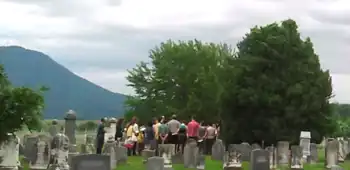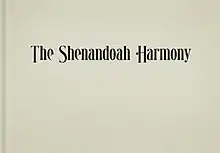
The Shenandoah Harmony is a 2013 republication of the works of Ananias Davisson (1780–1857) and other composers of his era, in the format used by modern shape note singing groups. Although a number of new shape note tune books were compiled and published in the two decades leading up to the publication of the Shenandoah Harmony,[1] this volume is notable as "the largest new four-shape tunebook published for more than 150 years."[2] The book is named after Shenandoah Valley, whose importance in the emergence of a distinctive Southern shape-note singing tradition has been noted by many musicologists.[3][4] Authentic South reporter Kelley Libby of WFAE, attending an all-day singing in Cross Keys, felt "transported to the Shenandoah Valley of the 1800s."[5]
Diffusion
All-day singing events dedicated to the Shenandoah Harmony have emerged not only in the mid-Atlantic region,[6] but also in the UK, Ireland, and Germany.[7][8] The popularity of the regional tunebook outside of the core area can be attributed to a design that has been optimized for sight-singing: "visually attractive, the songs are easy to read ... and the book feels good in your hand."[9][10] Another reason is that shape note singers love minor-key songs,[11] and the Shenandoah Harmony satisfies this peculiarity more than any other publication in current use, 52% of the tunes being minor.[12] A third reason is that, although many shape note singers know of Ananias Davisson as the composer of the iconic tune Idumea, the Sacred Harp does not contain any other songs by him;[13] thus, having an entire book inspired by Davisson's work appealed to many traditional shape note singers.[14]
Content

The Shenandoah Harmony has been called a "curatorial" compilation of fasola repertoire from the mid-Atlantic region[15] paying special attention to the works of Ananias Davisson.[16] The curatorial focus is on the Kentucky Harmony (1816) and subsequent publications by Ananias Davisson, who lived in the Shenandoah Valley but cultivated a network of singing-school teachers and composers in Tennessee, Kentucky, and Virginia.[17][18] The Shenandoah Harmony contains 24 compositions by Ananias Davisson, 52 songs from his Kentucky Harmony, and 46 songs from Supplement to the Kentucky Harmony. Works by other composers from his era have also been revived: five tunes by Elkanah Kelsey Dare, originally published in Wyeth's Repository, Part Second (1813); 13 by William Hauser (and another 13 from The Hesperian Harp, compiled and published by him in 1848); and 9 by Lucius or Amzi Chapin.[19] Reflecting the vitality of the tradition as practiced today are dozens of new compositions by singers living at time of publication (2013).[20] Tunes that already appear in the 1991 Denson edition of The Sacred Harp were avoided.[21]
Compilation and creation process
In 2010, the del Re family of Boyce, Virginia, who had been singing from publications of Ananias Davisson for 25 years, were joined by other singers who reviewed thousands of nineteenth-century shape-note songs from over seventy sources, as well as new compositions.[22] Members of the Music Committee composed alto parts when they were lacking. New compositions by living composers were reviewed, and dozens were included—not as a separate section, but integrated with traditional tunes. The Music Committee limited their selections to songs that would be accepted by contemporary singers: "All killer, no filler," as member Leyland del Re explained to a journalist.[23]
References
- ↑ Music, David W. (2017). "The Decline of the American Tune Book". The Choral Journal. 58 (1): 8–15. ISSN 0009-5028. JSTOR 26412810.
- ↑ "The Making of The Shenandoah Harmony". The Sacred Harp Publishing Company. 2013-07-29. Retrieved 2020-08-09.
- ↑ Harry Eskew, Shape-note hymnody in the Shenandoah Valley, 1816-1860. Tulane University, 1966.
- ↑ Steel, Warren. "Shape-Note Singing in the Shenandoah Valley". Retrieved 23 December 2019.
- ↑ Kelley, Libby. "Shenandoah Valley Shape Note Singers". Authentic South. 6:24 minutes in. PBS. WFAE. Retrieved 30 March 2020.
Sitting in the square of this shape note sing, I feel transported to the Shenandoah Valley of the 1800s. I picture harsh winters in a new world, and a long walk through dark woods, to arrive in a place made of rough boards.
- ↑ Recordings of all-day singings in Northern Shenandoah Valley (near the grave of Ananias Davisson) and in Lehigh Valley (PA) are posted to the "Shenandoah Harmony YouTube Channel". YouTube. Retrieved 21 February 2021.
- ↑ Lueck, Ellen (2017). "Ellen Lueck, Sacred Harp Singing In Europe: Its Pathways, Spaces, And Meanings" (PDF) (PhD diss). Wesleyan University. doi:10.14418/wes01.3.69. S2CID 193936027. Archived from the original (PDF) on 16 December 2019. Retrieved 21 February 2021.
{{cite journal}}: Cite journal requires|journal=(help) - ↑ List of singings at the Shenandoah Harmony page. All-Day Singings, retrieved 13 December 2019
- ↑ Taaffe, Brendan. "Book Review—The Shenandoah Harmony, Country Dance & Song Society (Easthampton, MA)". Retrieved 23 December 2019.
- ↑ "The amount of attention that the editors paid to these practical and ergonomic considerations speaks to both the fluency exhibited by the contemporary compilers with regard to fasola tradition and convention, as well as to the highly evolved and well-adapted physical form of the shape note tunebook." (p. 153) Streicker, A. Mitchell (2019). "The Shenandoah Harmony (3rd printing of 1st ed., 2014)" (PDF). The Fasola Tunebook Publication Renaissance (Masters thesis). University of Florida. pp. 151–160. Retrieved 1 January 2020.
- ↑ Buell E. Cobb, Jr., in The Sacred Harp: A Tradition and Its Music (University of Georgia Press, 2004), p. 34, states that "the high percentage of "minor music" in the Sacred Harp (roughly two songs out of five) is an anachronism"; in fact, only 23% of Sacred Harp songs are minor, but they are indeed sung about 40% of the time.
- ↑ "The editions of The Kentucky Harmony and The Tennessee Harmony are roughly 60% minor; even the early editions of The Easy Instructor are over 50% minor. As our book has evolved, we’ve added songs from other sources; the finished book will have about 52% minor songs." Hall, Rachel. "One of the most beautiful of those old minors". Archived from the original on 9 December 2019. Retrieved 23 December 2019.
- ↑ fasola.org. "Indexes for The Sacred Harp, 1991 Edition: Composers". Retrieved 23 December 2019.
- ↑ "Admired for its scholarship, curation, and design, its use has quickly surpassed any other recently published tunebook of its kind." (page 119 of) Davis, Clinton (2016). "Chapter 5 From Seeking To Dwelling". Beyond Revival: Composition and Compilation Amidst the Sacred Harp Revival (PhD). UC San Diego. Retrieved 22 December 2019.
- ↑ Davis, Clinton (2016). "Chapter 5 From Seeking To Dwelling". Beyond Revival: Composition and Compilation Amidst the Sacred Harp Revival (PhD). UC San Diego. Retrieved 22 December 2019.. Another tunebook based on the "curatorial themes of regionality and place" mentioned by Davis is The American Vocalist of Maine.
- ↑ "The original inspiration for The Shenandoah Harmony was to create a tunebook that included the best of the shape-note songs collected, printed, and published by Ananias Davisson from 1816 to 1826 in the Shenandoah Valley of Virginia." "Shenandoah Harmony: A New Four-Shape Tunebook»About". Archived from the original on 30 July 2021. Retrieved 23 December 2019.
- ↑ David W. Music, "Ananias Davisson, Robert Boyd, Reubin Monday, John Martin, and Archibald Rhea in East Tennessee, 1816-26", American Music Vol. 1, No. 3 (Autumn, 1983), pp. 72-84.
- ↑ Barnett, Joshua Rush (Summer 2015). "The Brandstetter Tunebook: Shape-Note Dissemination and the Germans of Western Maryland". American Music. 33 (2): 176–218. doi:10.5406/americanmusic.33.2.0176. hdl:1903/12804. JSTOR 10.5406/americanmusic.33.2.0176. S2CID 160357611.
- ↑ Song counts are from the "Index" at the back of the Shenandoah Harmony (no pagination for end matter).
- ↑ "Given that the original project had as its crux the tunes from Ananias Davisson's publications in the second and third decades of the 19th century, the decision to include more than sixty 20th- and 21st-century compositions in The Shenandoah Harmony was a bold one, but a wise one." Macadam, Sheila Girling; Macadam, Edwin. "The Shenandoah Harmony, 2012 - A ray of light in an otherwise troubled world". Retrieved 21 February 2021.
- ↑ However, alternative versions of some tunes are provided, such as alternate words for Stafford (page 78 in both books), replacing the anti-Semitic lyrics of Isaac Watts with uplifting poetry by Joseph Hart.
- ↑ Hall, Rachel Wells (July 29, 2013). "The making of the Shenandoah Harmony". Sacred Harp Publishing Company Newsletter. Carrollton, GA: Sacred Harp Publishing Company. Retrieved 1 January 2020.
- ↑ "Our quote was 'all killer, no filler,'" del Re says. "The songs that made it deserve to be back out there — they're gorgeous."Baldwin, Brent. "Family Affair: The Richmond Shape Note Singers teach new generations to sing the oldest American folk songs". Style Weekly. Richmond VA. Retrieved 1 January 2020.
External links
- Shenandoah Harmony Homepage Archived 2021-07-30 at the Wayback Machine
- Sacred Harp Bremen, learning pages for individual songs in the Shenandoah Harmony.